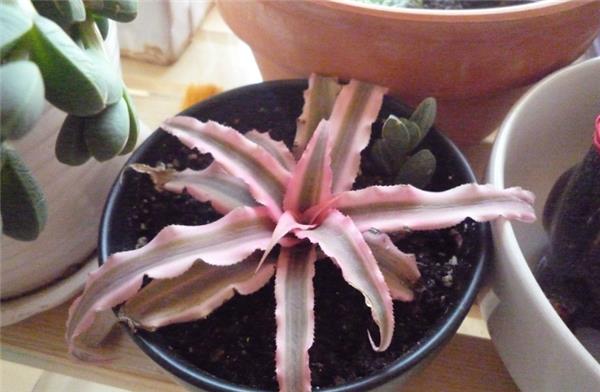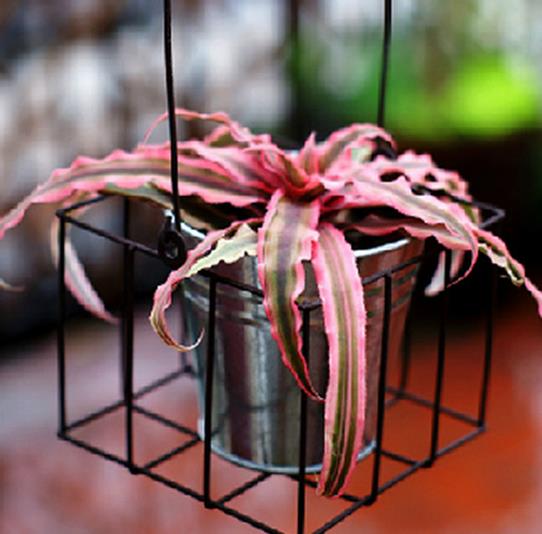What are the types of fruit and vegetables?
Ji pineapple is an ornamental plant. Its leaves are light red and spread outward, showing vitality. It is a necessary plant for many flower growers. Now, let's take a look at the relevant knowledge of Ji pineapple.

First, the introduction of Ji Pengli
Grate leaf pineapple, also known as Xiaohuaji pineapple. The leaf is long oval-lanceolate, the petiole is long, the leaf surface is green-brown, with light green stripes; scape protrudes from the axils of the leaves, and the flowers are small and white.
Second, the morphological characteristics of Ji pineapple.
Perennial evergreen herb. The underground part has tuberous rhizomes and the aboveground part is almost stemless. The leaves are densely clustered from the rhizome, each cluster has several leaves, the horizontal extension is rosette, the leaf is hard, the edge is wavy, and has soft thorns, the leaf is strip-shaped, the apex is acuminate, the back of the leaf is white phosphorous, the mesophyll is thick and leathery, and the surface is green-brown. Flowers bisexual, white, monoecious, scape drawn from leaf clusters, short column, inflorescence rosette, 4 involucral bracts triangular, white, leathery.

III. Variety classification of Ji pineapple
1. Grate leaf pineapple
Also known as Xiaohuaji pineapple. The leaf is long oval-lanceolate, the petiole is long, the leaf surface is green-brown, with light green stripes; scape protrudes from the axils of the leaves, and the flowers are small and white.
two。 Dichromatic pineapple
Also known as double-striped Ji pineapple. The leaves are green with red and yellow longitudinal stripes.
3. Tiger spot Ji pineapple
The leaves are clustered, the middle leaves are larger, and there are red, yellow and white transverse interlaced stripes on the leaves, like tiger spots.
4. Red leaf pineapple
The leaves are short, red-yellow or reddish-brown.

4. The mode of reproduction of Ji pineapple
Ji pineapple was propagated by sowing method, cutting method and split method.
1. Sowing method
The seeds can only be obtained by artificial pollination. The seeds are sown in pots from late April to mid-May in spring and can germinate in 1-2 weeks at 25 ℃, but the seedlings grow slowly and can grow into plants after 3 years.
two。 Intercalation method
The leaf axis beside the mother plant was cut off from the base, the first 3 leaflets were retained and inserted into the sand bed, shaded and maintained to protect the higher humidity. At the temperature of about 30 ℃, it could take root in about 3 weeks, and the seedlings could be divided after 7 weeks.
3. Split-plant method
It is a commonly used method, combined with changing pots in spring, separating the sprouting tillers between the leaves of flowering mother plants, planting after cutting with rhizomes, shading and maintenance, which is very easy to survive. Ramet propagation is mainly suitable for herbaceous flowers with tufted characteristics.

4. Ramet time
It is best after the soil is thawed in early spring (February and March).
5. Ramet method
Take the mother plant out of the flowerpot, shake off the excess potted soil, separate the root system as much as possible, and cut it into two or more plants with a sharp knife, each with a considerable root system. and its leaves are properly trimmed to facilitate survival.
6. Disinfection in pots
Soak the split plant in 1500 times chlorothalonil solution for five minutes, then take out the cold dry, and then serve. You can also irrigate the root with chlorothalonil immediately after potting.
7. Management after ramet
Put the ramet into the basin and irrigate the root or water once. Because its root system is greatly damaged and its water absorption capacity is very weak, it takes about 3-4 weeks to recover new roots. Therefore, it is necessary to control watering within 3-4 weeks after ramet to avoid rotting roots, but the transpiration of its leaves is not affected. In order to maintain the water balance of the leaves, it is necessary to spray the leaf surface 1-3 times a day (spray more at high temperature, less spray at low temperature or no spray at low temperature). Don't fertilize it these days. After the split, but also pay attention to the sun is too strong, it is best to put in the shade to maintain.
The above is the relevant knowledge of Ji Pengli. I hope I can help you.
- Prev

The characteristics of garlic flower A detailed introduction of garlic flower
The characteristics of garlic flower A detailed introduction of garlic flower
- Next

The mountains are covered with the introduction of spring cuckoos and the production of potted plants.
The mountains are covered with the introduction of spring cuckoos and the production of potted plants.
Related
- Wuhan Hospital Iron Tree Blooming Result Was Instantly Frightened by the Gardener Master
- Which variety of camellia is the most fragrant and best? Which one do you like best?
- What is the small blue coat, the breeding methods and matters needing attention of the succulent plant
- Dormancy time and maintenance management of succulent plants during dormancy
- Minas succulent how to raise, Minas succulent plant pictures
- What are the varieties of winter succulent plants
- How to raise succulent plants in twelve rolls? let's take a look at some experience of breeding twelve rolls.
- Attention should be paid to water control for succulent plants during dormant period (winter and summer)
- Watering experience of twelve rolls of succulent plants
- Techniques for fertilizing succulent plants. An article will let you know how to fertilize succulent plants.

